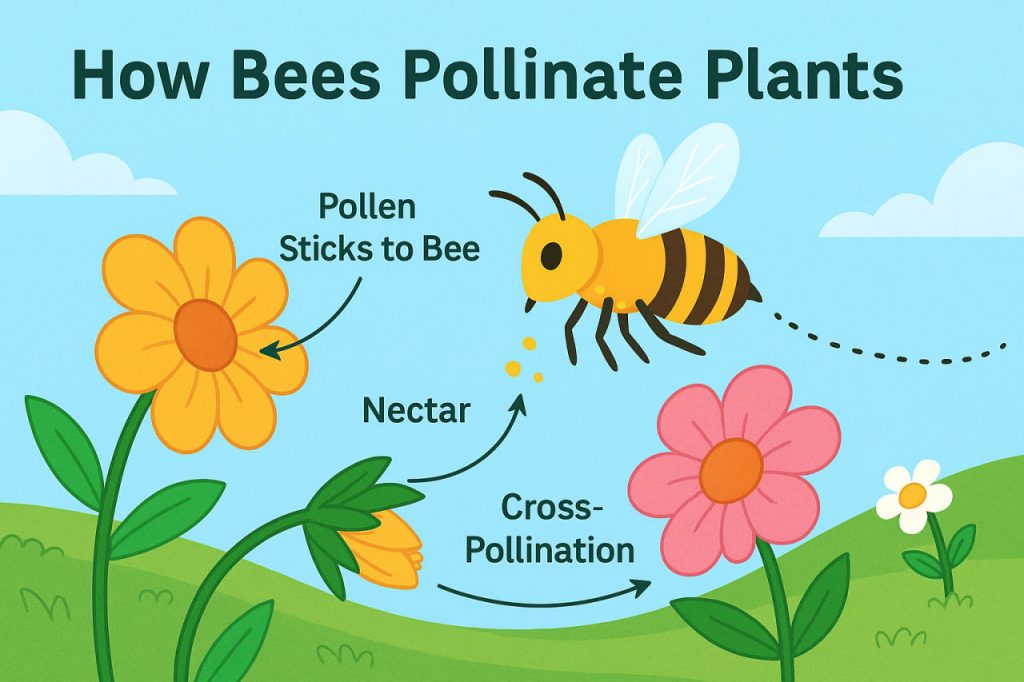Bees are among the most effective and essential pollinators on Earth. Their ability to transfer pollen from flower to flower not only allows plants to reproduce, but also supports the production of fruits, vegetables, nuts, and seeds that humans and animals rely on. Without bees, many ecosystems—and food systems—would collapse.
What Is Pollination?
Pollination is the process by which pollen (the male reproductive material of a plant) is transferred to the stigma (the female part) of the same species, enabling fertilization and the formation of seeds.
Some plants are pollinated by wind or water, but over 80% of flowering plants depend on insects, especially bees, for pollination.
How Bees Pollinate
- Attracted by Flowers
Bees are drawn to flowers by bright colors, pleasant scents, and nectar, which is their food source. - Landing and Feeding
When a bee lands on a flower, it uses its proboscis (tongue) to drink the nectar hidden deep within the flower. - Collecting Pollen
As the bee moves around, pollen grains stick to its hairy body and legs. Some bees also collect pollen into special pollen baskets on their legs. - Flying to the Next Flower
The bee then flies to another flower. As it feeds again, some of the pollen rubs off onto the second flower’s stigma—this is cross-pollination. - Pollination Achieved
If the pollen matches the flower’s species, fertilization occurs, leading to the production of seeds and fruits.
Why Bees Are So Good at Pollination
- Hairy Bodies trap and hold pollen efficiently
- Loyalty to One Species during each trip improves accuracy
- Buzz Pollination: Some bees vibrate to release pollen from tightly closed flowers (e.g., tomatoes)
- Efficient Movement: A single bee may visit thousands of flowers a day
Types of Bees Involved
- Honeybees: Domesticated, live in hives, widely used in agriculture
- Bumblebees: Larger, great at buzz pollination
- Solitary bees (e.g., mason bees, leafcutter bees): Excellent pollinators, active early in the season
Each type plays a unique role in supporting biodiversity and crop production.
Importance of Bees in Agriculture
Bees pollinate:
- Apples, almonds, blueberries, cucumbers, tomatoes, melons, avocados, and hundreds more
- $500+ billion USD worth of global food production annually
Many crops would dramatically decline in quality and quantity without bees.
Threats to Bees
- Pesticides and herbicides
- Habitat loss from urbanization and farming practices
- Diseases and parasites (like Varroa mites)
- Climate change affecting flowering times and food sources
Protecting bees means protecting food security and natural ecosystems.
How to Help Bees
- Plant bee-friendly flowers and avoid chemicals
- Support local beekeepers
- Provide water sources and safe shelter (like bee hotels)
- Raise awareness and support pollinator protection laws
Conclusion
Bees play a quiet but vital role in our world. Through their daily work of pollinating plants, they keep ecosystems healthy and our plates full. Protecting bees is not just about saving insects—it’s about preserving life itself.
Glossary
- Pollination: Transfer of pollen from the male to female parts of a plant
- Stigma: The part of the flower that receives pollen
- Nectar: A sweet liquid that attracts pollinators
- Cross-pollination: Pollen transfer between different plants of the same species
- Buzz pollination: A bee’s vibration to release pollen


